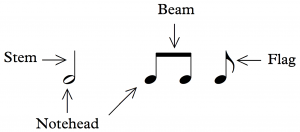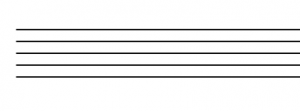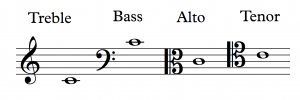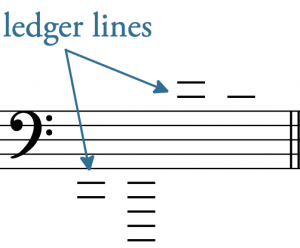Fundamentals
2 Notation of Notes, Clefs, and Ledger Lines
Chelsey Hamm
Key Takeaways
- A note indicates both pitch and rhythm.
- Notes are written on a staff. Higher frequency (shorter wavelength) notes are written above lower frequency (longer wavelength) notes (i.e. higher notes are placed above lower ones).
- A notehead must be written carefully on a staff. A notehead is oval (not round); additionally, it should be neither too large nor too small, and is tilted slightly upwards towards the right.
- A clef indicates which pitches are assigned to the lines and spaces on a staff.
- Extra lines called ledger lines extend a staff higher or lower.
Western musical notation privileges two musical features: pitch and rhythm. Pitches are notated vertically (on the y-axis), while rhythms are notated horizontally (on the x-axis). Western musical notation is read left-to-right and top-to-bottom, like the page of a book in written English.
Notation of Notes
A note indicates both pitch and rhythm. A written note consists of a notehead (either empty or filled in), and optionally can include a stem, beam, or flag (see Rhythmic and Rest Values). Example 1 shows an illustration of noteheads, stems, beams, and flags:

Staff Notation
A staff (plural staves) is essential for conveying pitch. A staff consists of five horizontal lines, evenly spaced. Example 2 depicts a staff:

Placing Notes on a Staff
Noteheads on a line should fill in half of each space above and below. Noteheads in a space should just touch the lines above and below. Example 3 shows examples of correct noteheads, both open and filled in, both on lines and in spaces:

Example 4 shows incorrect noteheads. As you can see, noteheads can be drawn too small, too big, or the wrong shape.

Noteheads should be oval (not round), and they are tilted slightly upwards towards the right.
Clefs
When notes are drawn on the lines and spaces of a staff, those notes represent pitches. Musicians use spatial metaphors to describe notes placed on a staff. For example, notes appearing towards the top of a staff are said to be “higher” than those appearing towards the bottom of a staff (which are said to be “lower”). Higher notes have a shorter wavelength (and consequently a higher frequency); lower notes have a longer wavelength (and consequently a lower frequency). Such spatial metaphors vary with milieu—i.e. across cultures and time periods. For example, for some music theorists in ancient Greece higher sounding notes were visually placed below lower sounding notes.[1] This is because some ancient Greek music theorists were likely most familiar with string instruments, which include violins, guitars, and harps. Example 5 demonstrates why this was the case for some authors in ancient Greece:
Example 5. Dr. Jacob Tews (Christopher Newport University) explains more about ancient Greek musical notation.
Notes cannot convey pitch information if the staff on which they appear does not include a clef. A clef indicates which pitches are assigned to the lines and spaces on a staff (also see Reading Clefs). The two most commonly used clefs today are the treble clef and bass clef. Two other clefs that you may encounter are the alto clef and the tenor clef. Example 6 shows four notes, each placed after a treble, bass, alto, and tenor clef:

Higher notes, such as those played by a flute or sung by a soprano, are usually written in treble clef, and lower notes, such as those played by a trombone or sung by a bass, are usually written in bass clef. Alto and tenor clefs are relatively rare compared to treble and bass. But in some cases, alto clef is used for medium-high notes, and tenor clef is used for medium-low notes.
Drawing Clefs
One can draw a treble clef in three simple steps, as demonstrated in Example 7:

First, draw a slanted vertical line that extends slightly above and below the staff. Next, draw a half circle that intersects with your slanted line at the second from top line of the staff. Finally, circle around the second from bottom line of the staff. Likewise, one can also draw a bass clef in three steps, as shown in Example 8:

First, draw a dot on the second from top line of the staff. Next, draw a backwards ‘C’ that ends in the bottom space of the staff, making sure that the top part of the ‘C’ does not extend above the staff. Finally, place two dots to the right of the backwards ‘C’, in the top two spaces of the staff. One can draw an alto clef in four steps, as Example 9 shows:

First, draw a thick vertical line that spans the staff. Next, draw a thinner vertical line next to the thicker vertical line. Third, draw two backwards ‘C’s, the first taking up slightly less than the top half of the staff and the second taking up slightly less than the bottom half of the staff. Finally, connect these backwards ‘C’s with a point that rests on the middle line of the staff.
A tenor clef is also drawn in four steps, as seen in Example 10:

A tenor clef and an alto clef are drawn the same; however, the tenor clef is shifted up one line of the staff higher than an alto clef. First, draw a thick vertical line that begins on the second from bottom line of the staff and extends slightly above the staff. Next, draw a thinner vertical line next to the thicker vertical line. Third, draw two backwards ‘C’s, the first extending slightly above the top half of the staff and the second taking up slightly less than the middle two spaces of the staff. Finally, connect these backwards ‘C’s with a point that rests on the second from top line of the staff.
Writing Ledger Lines
When notes are too high or low to be written on a staff, small lines are drawn to extend the staff. These extra lines are called ledger lines. Example 11 shows ledger lines written above and below a staff:

Example 12 shows notes (with stems and beams) drawn on ledger lines, above and below a staff.

When writing ledger lines, be sure not to put in an extra ledger line above or below the note you are writing. Example 13 first shows the correct way of writing notes on ledger lines, as well as the incorrect way, with extra ledger lines above and below the notes:

- Pitch and Frequency (the Physics of Sound) (physicsclassroom.com)
- The Staff (essential-music-theory.com)
- Drawing Notes (YouTube)
- Clefs (Music Notes Now)
- Drawing Treble and Bass Clefs (YouTube)
- Drawing C Clefs (Ultimate Music Theory)
- The Staff, Clefs, and Ledger Lines (musictheory.net)
- For one example see André Barbera's The Euclidean Division of the Canon: Greek and Latin Sources. New Critical Texts and Translations on Facing Pages, with an Introduction, Annotations, and Indices Verborum and Nominum and Rerum (Lincoln: University of Nebraska Press, 1991), 276–9. ↵
Includes both a pitch and rhythmic component; may include a stem, beam, and/or flag
Refers to how "high" or "low" a sound is
The duration of musical sounds and rests in time
Five horizontal lines that are evenly spaced on which notes are placed
The elliptical part of the note that can be either filled in (black) or outlined (white)
A symbol placed on the left side of a staff, which indicates which notes are assigned to different lines and spaces
Small lines written above or below a staff to extend the staff's range of notes
The vertical line that originates at the notehead
The horizontal lines that connect certain groups of notes together
A curved line placed at the end of a stem
A physical and/or social setting
An instrument that produces sound via one or more vibrating strings
Also known as the "G" clef, a treble clef designates the lowest line of a staff as the pitch E4
Also known as the "F" clef, a bass clef designates the lowest line of a staff as the pitch G2
Also known as a "C" clef, an alto clef designates the lowest line of a staff as the pitch F3
Also known as a "C" clef, a tenor clef designates the lowest line of a staff as the pitch D3

